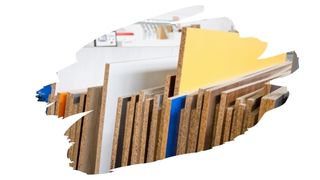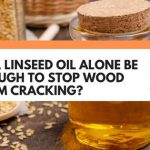Are you wondering how to finish that MDF jig, but you’re worried that a coat of water-based finish will do more harm than good? Suppose there was a finish out there that worked well on MDF… could Linseed oil be just such a finish?
Well, in this post, you will find out whether Linseed oil can improve MDF’s durability. You will also learn why Linseed oils curing time can make it difficult to use it as a primer.
And we explain why you should only use oil-based finishes on MDF…

This post may contain affiliate links to products that we receive a commission for (at no additional cost to you). Learn more here.
What’s The Best Kind Of Finish For MDF?
As long as the finish is not water-based, it can be readily applied to MDF. This is because MDF will soak up the water out of a water-based finish far too quickly.
As a result, water-based finishes/sealers/paints struggle to coat evenly on MDF. Or worse, they can struggle to adhere to MDF at all.
Related Post: A Quick Guide To Fastening MDF (+ The Best Screws For MDF)
Can You Apply Oil Onto MDF?
MDF, (also known as Medium Density Fiberboard), is an engineered material created by gluing wood shavings together. So, just like natural timber, this manufactured wood can take on any oil-based finish, sealer or paint.
Still, MDF has a sponge-like texture at its core, so it will soak up a penetrating oil finish (like Linseed oil) more readily than other types of manufactured wood.
Which means you will need to apply more than just the standard 2-3 coats of Linseed oil, (if you really want to saturate MDF with this finish).

And Will Linseed Oil Make MDF More Durable?
MDF is already one of the more stable manufactured woods on the market.
It has more heft to it than plywood. It’s smooth face-side is tough enough to handle wear and tear. And MDF doesn’t move around when the temperature or humidity shifts (the way solid natural lumber can tend to do).
But, MDF is easily water-damaged. And even a little water can cause MDF to warp and bow.
Now, Linseed oil won’t toughen MDF and make it durable. And it certainly won’t make MDF waterproof.
That’s because Linseed oil isn’t even really a sealant. It is more of a wood preservative, just like Tung oil or Danish oil.
Related Post: Can You Use Tung Oil On MDF?
Which means that, at most, Linseed can make MDF less water absorbent. And this reduced water-absorbency can help increase the lifespan of a sheet of MDF.
Can You Use Boiled Linseed Oil On MDF? Yes, you can. In fact, you are better off using a boiled Linseed oil finish (also referred to as BLO) than raw Linseed oil. That is because boiled Linseed oil dries much faster than its raw equivalent.
Can You Seal MDF With Linseed Oil?
Linseed oil doesn’t do a good job when it comes to waterproofing. Instead, this finish does it’s best work by nourishing old lumber, and enhancing the appearance of wood.
So, Linseed oil is not going to do the job of sealing MDF edges well enough. And it certainly won’t completely prevent water and moisture from soaking into this manufactured wood.
And Linseed oil’s lack of waterproofing is only half the problem. The other half? The length of time it takes for Linseed oil to cure.
What Is The Difference Between An Oil Finish Drying and Curing? A dry oil finish has gone through an evaporation process, turning it from a liquid into a solid (yet still soft) film. A cured oil finish has gone through a further (yet separate) chemical reaction process, turning it from a soft film into a hard resin.

The Problem With Using Linseed Oil As A Primer For MDF
Linseed oil is infamous for taking absolutely ages to cure. Depending on your local climate, raw Linseed oil can take anywhere from 2 weeks to 10 weeks to cure completely.
Even boiled Linseed oil, (raw Linseed oils fast-drying counterpart), can take 2-3 weeks to cure.
What Is The Difference Between BLO and Raw Linseed Oil? Boiled Linseed oil dries and cures much faster than raw linseed oil. Boiled Linseed oil is created when raw Linseed oil is put through a special super-heated treatment process. During this ‘boiling’ process, drying agents are added to Linseed oil.
In addition to this, MDF is well-known for soaking up more than its fair share of penetrating oil finish coats.
So, if you apply a Linseed oil finish onto MDF, that Linseed oil may take a little longer to fully cure through underneath the surface. And that uncured oil can seep up through the surface in spots.
This isn’t a problem, generally, if you’re using Linseed oil as a final finish.
But, it can create issues later on, if you use Linseed oil as a primer. Especially since those weeping uncured oil spots can make it difficult for any top coat sealant to adhere to MDF.
Related Post: Can You Put Polyurethane Over A Tru-oil Finish? [3 Quick & Easy Tips]
To Sum Up, Here Are The 3 Main Takeaways From This Post…
- 1). MDF is very water absorbent. So, you should not use water-based finishes or paints on this material.
- 2). You can apply Linseed oil onto MDF. But, this slow-drying finish may take even longer than usual to fully cure inside of MDF material.
- 3). Linseed oil is not a sealant. So, do not use Linseed oil to seal MDF edges (or otherwise waterproof this manufactured wood).



